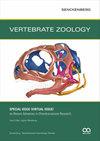黑暗中的进化:生活在含水层的盲鲶鱼Horaglanis意外的遗传多样性和形态停滞
IF 2.4
2区 生物学
Q1 ZOOLOGY
引用次数: 2
摘要
印度南部喀拉拉邦的红土含水层中有一群神秘的虾虎鱼,它们很少出现,只有在挖掘和清理家井时才会浮出水面。在这里,我们关注的是这一群体中最不寻常的成员之一,Horaglanis鲶鱼,这是一种罕见的、微小的、失明的、无色素的、严格居住在含水层中的物种。一项由分子系统发育分析支持的为期六年的探索性公民科学调查揭示了对贺兰属的多样性、分布和种群结构的新见解。该属的特征是种内和种间遗传分化程度高,系统发育上不同的物种在线粒体细胞色素氧化酶亚基1基因中恢复到7.0%以上的遗传距离阈值。然而,与这种深刻的基因差异形成对比的是外部形态的显著停滞。我们确定并描述了一个新的神秘物种,Horaglanis populi,这是目前所有已知物种的姐妹群。所有四个物种都有多个单倍型。不匹配分布表明,人口最近没有经历过扩张。本文章由计算机程序翻译,如有差异,请以英文原文为准。
Evolution in the dark: Unexpected genetic diversity and morphological stasis in the blind, aquifer-dwelling catfish Horaglanis
The lateritic aquifers of the southern Indian state of Kerala harbour a unique assemblage of enigmatic stygobitic fishes which are encountered very rarely, only when they surface during the digging and cleaning of homestead wells. Here, we focus on one of the most unusual members of this group, the catfish Horaglanis, a genus of rarely-collected, tiny, blind, pigment less, and strictly aquifer-residing species. A six-year exploratory and citizen-science backed survey supported by molecular phylogenetic analysis reveals novel insights into the diversity, distribution and population structure of Horaglanis. The genus is characterized by high levels of intraspecific and interspecific genetic divergence, with phylogenetically distinct species recovered above a 7.0% genetic-distance threshold in the mitochondrial cytochrome oxidase subunit 1 gene. Contrasting with this deep genetic divergence, however, is a remarkable stasis in external morphology. We identify and describe a new cryptic species, Horaglanis populi, a lineage that is the sister group of all currently known species. All four species are represented by multiple haplotypes. Mismatch distribution reveals that populations have not experienced recent expansions.
求助全文
通过发布文献求助,成功后即可免费获取论文全文。
去求助
来源期刊

Vertebrate Zoology
ZOOLOGY-
CiteScore
4.00
自引率
19.00%
发文量
42
审稿时长
>12 weeks
期刊介绍:
Research fields covered by VERTEBRATE ZOOLOGY are taxonomy, morphology, anatomy, phylogeny (molecular and morphology-based), historical biogeography, and palaeontology of vertebrates.
 求助内容:
求助内容: 应助结果提醒方式:
应助结果提醒方式:


